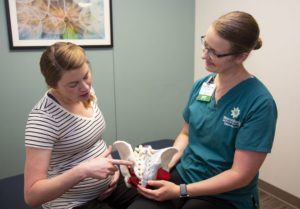
Make no doubt about it: pregnancy is a life and body-altering experience. Your body goes through so many changes to accommodate your growing baby. These changes often come with some unpleasant aches and pains that can occur during pregnancy and long after delivery. Coupled with those ever-changing hormones, it can be a recipe for disaster.
It’s only been a couple of years since I last gave birth (for the fourth time), but I remember those pregnancy aches and pains like it was yesterday. I even remember the pain from the three pregnancies and deliveries before that. When people say you forget all about the pain in those childbearing years, I’m not sure whom they’re referring to or when that will supposedly happen, because I haven’t forgotten. I still have episodes of pelvic and back pain today.
Of course, I’d argue that my pain was relatively normal. Don’t get me wrong: there were days when the pain felt like my pelvis was ripping apart. It was a struggle to put my pants on, because I couldn’t bear to stand on one leg. Some days, just getting out of bed seemed impossible.
Hope for Pregnancy & Postpartum Aches and Pains
For some women, however, these pains can be downright debilitating – and not something that extra strength ibuprofen can fix either. Did you know 30 to 50 percent of women report pain severe enough to lose time from work and refrain from social interactions? With everything our bodies (and minds) go through during pregnancy and postpartum, this type of pain hardly seems fair.
After having four kids, which resulted in one emergency C-section, three subsequent VBACs (vaginal birth after C-section) and some unforgettable pelvic pain, I was thrilled to learn that there’s hope.
I recently sat down with Jenny Schiek, a physical therapist at Missouri Baptist Medical Center, who specializes in treating pelvic floor pain in pregnant and postpartum women. She discussed several things you can do before, during and after pregnancy to lessen that pelvic pain. Turns out, Jenny’s the answer to my postpartum-pelvic-pain prayers…she might be the answer to yours, too.
What is the most common complaint you get from pregnant women?
Many of the cases I treat involve a form of symphysis pubis dysfunction (SPD), which affects the joint in front of your pubic bone. It’s actually one of the most common pelvic pain complaints that affects 60 percent of pregnant women.
SPD occurs due to hormonal changes that cause ligaments around the symphysis pubis to become stretchy, soft, and relaxed. This makes the whole area unstable and can cause pain, which is more noticeable when climbing stairs or trying to sleep. I’ve treated pregnant women whose SPD pain is so severe that walking comfortably is a challenge. The pain tends to get worse in the second and third trimesters, often lasting days or even weeks after delivery.
So, what can women do to ease this type of pelvic pain?
First, being healthy and physically fit before pregnancy can help you avoid pelvic pain and SPD altogether. The key is to establish a strong core to better stabilize your pelvis during pregnancy. If you still end up developing SPD, you can consult with a physical therapist with your OBGYN’s approval. Just be sure to find someone who specializes in treating pregnant women and the pelvic floor.
My goal with all of my patients (pregnant and postpartum) is to restore quality of life. I focus on any pelvic instability they may be experiencing, showing them certain positions and exercises they can do to strengthen their core and pelvic floor, specifically:
- Movements to decrease pain during transitions;
- Range of motion exercises to improve posture;
- Different sleep positions to try for comfort and better sleep; and
- Support braces if needed to help ease any heaviness or pressure.
Are there ways to reduce your risk for developing postpartum issues?
There are a number of common postpartum conditions that affect many women, such as urinary incontinence, prolapse, low back pain, and upper back pain due to enlarged breasts. Fortunately, there are things you can do during pregnancy to reduce your risk for these issues, including abdominal exercises to strengthen the core muscles; Kegel exercises to strengthen the pelvic floor, and yoga poses to help increase flexibility.
So, I had a C-section with my first delivery 11 years ago, and the scar and bulge of scar tissue still bother me. Is there a way to minimize a C-section scar and any associated pain/sensitivity?
C-section scars may cause a slight postural change or a ‘pulling forward.’ That, along with a decrease in the support of the back from the abdominal muscles, causes lower back pain. Basic physical therapy can help improve your posture and any lower back pain.
As far as the bulge of scar tissue that remains, there are myofascial release (MFR) manual therapy techniques that we use to reduce the amount of scar tissue as well as any sensitivity around the scar. More importantly, this treatment can breakdown any abdominal adhesions that may have formed as the body attempts to repair itself following a C-section. These abdominal adhesions can actually lead to bowel obstructions, decreased fertility, pain with intercourse, dysfunction, or may even require additional surgeries.
With the MFR techniques we use, the adhesions are gradually released, resulting in less scar tissue and reduced pelvic pain. My patients are often surprised by how little touch and pressure we use to breakdown their abdominal adhesions. Better yet, the technique can be used years after a C-section. So, it could even work on your 11-year-old scar.
Thank you for your time, Jenny, and for sharing your advice on how to reduce pelvic pain during pregnancy and postpartum!
Absolutely! No matter where you are on your childbearing journey – whether you’re in your first, second or third trimester or you delivered your baby last week (or even years ago) – chronic pain should not be a central part of your daily life. It’s never too late to find relief; physical therapy and rehabilitation can help. Talk to your OBGYN to see if you’re eligible.
For more information about Missouri Baptist Medical Center’s pregnancy and postpartum rehabilitation program, call (314) 996-3534 or visit missouribaptist.org/therapy.











This is such an informative article. I, too, have 4 kids and I found it so surprising how differently my body reacted for the 4th as opposed to the first ones. I never considered PT or really knew it was an option but I bet it would have made a huge difference.
Physical therapy postpartum was so beneficial for me. I wish consultation with a physical therapist was standard care as pre- and postnatal care.
I just had my second child (at MoBap!) and the care we received was phenomenal. Fortunately I feel great right now, but I wouldn’t hesitate in reaching out for help. Pregnancy was difficult for me (SPD was terrible), and I didn’t realize I had options (other than rest) for dealing with that pain – so good to know for future pregnancies.
Comments are closed.